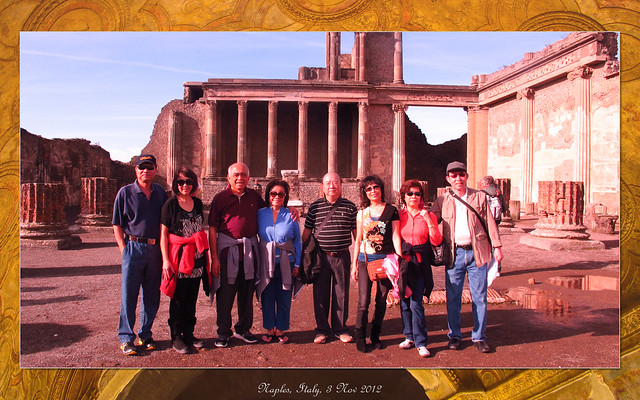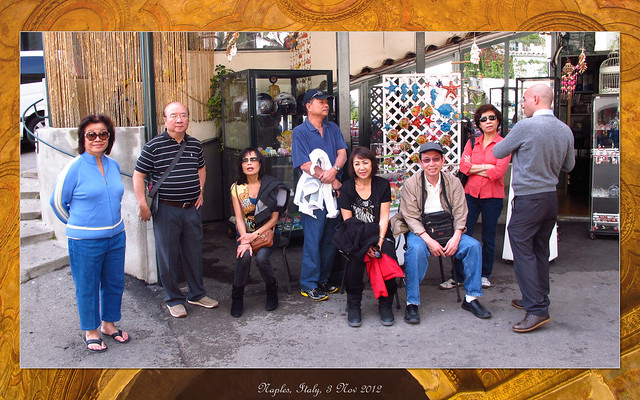November 3, 2012:
Click on the thumbnail below for a photo slideshow!

POMPEI ITALY:
The city of Pompeii is a partially buried Roman town-city near modern Naples in the Italian region of Campania, in the territory of the comune of Pompei. Along with Herculaneum, Pompeii was partially destroyed and buried under 4 to 6 m (13 to 20 ft) of ash and pumice in the eruption of Mount Vesuvius in AD 79.
Pompeii was lost for nearly 1,700 years before its rediscovery in 1748. Since then, its excavation has provided an extraordinarily detailed insight into the life of a city during the Pax Romana. Today, this UNESCO World Heritage Site is one of the most popular tourist attractions of Italy, with approximately 2,500,000 visitors every year.
November 3, 2012: In the Destroyed City POMPEI (This city was destroyed on August 24, 79 A.D. by the eruption of the active volcano Vesuvius)
Click on the thumbnail below for a photo slideshow!

Vesuvius is the only active volcano in mainland Europe, and has produced some of the continent's largest volcanic eruptions. Located on Italy's west coast, it overlooks the Bay and City of Naples and sits in the crater of the ancient Somma volcano. Vesuvius is most famous for the 79 A.D. eruption which destroyed the Roman cities of Pompeii and Herculaneum. Though the volcano's last eruption was in 1944, it still represents a great danger to the cities that surround it, especially the busy metropolis of Naples.
Pompei Live!
Pompeii - Buried Alive
Two-thousand years ago, Rome was an all-powerful empire and Pompeii was one of its prosperous provincial towns-until Mount Vesuvius exploded in the largest eruption ever recorded. In a matter of hours the thriving city was entombed under a thick layer of ash and debris, undiscovered for centuries.
Pompeii Rediscovered:
Movie: Pompeii - The Last Day
The history of the eruption that buried Pompeii.
SORRENTO ITALY
November 3, 2012:
Click on the thumbnail below for a photo slideshow!

Sorrento, Italy
Situated on a terrace overlooking the splendid Amalfi coastline, Sorrento is imbued with charm and echoes of the ancient past. Its position is perfect, affording a stunning panorama of the bay of Naples, but its list of attributes is replete. Parks, villas, orange, lemon and olive groves, picturesque narrow streets and resplendent weather, have ensured a steady stream of visitors to the town throughout the year and over the centuries. The town does suffer irregular building projects, but even this has not greatly overshadowed its rustic sea side town appeal.
The name of the town has its origins in antiquity and derives from a Greek word meaning "Flowing" due to the form of the town which appears to flow over the limestone tuff on which the town stands, defining the edge of the cliffs.
Curving along the coastline, erosion has carved the rock-face over the centuries into the majestic crags which climb to the skyline, forming the world renowned beauty of the Amalfi coast. Its legendary origins derive from the word Siren or Mermaids, mythical feminine creatures with celestial voices and hideous aspect, whose hands and songs lured unsuspecting sailors to the terror of the rocks, breaking their ships and wreaking romantic and tragic havoc.
Sorrento's history is connected to the ancient Island of Lipari, originally colonized in 8 B.C. by Corinthians who, exploring the lands, later settled in neighboring Sorrento. With the arrival of Imperial Rome, Sorrento was allied to the Romans, and to this day, the city centre bears testimony in the classically Roman layout of the streets to the presence of the Empire.
In the Middle Ages Sorrento fell into the hands of the Goths and the Byzantines, but resisted and repelled the advances of the Lombards of Benevento despite a siege. Due to Sorrento's proximity to the sea however, it was often raided and sacked in the 1500's by Pirates and sailors from the Harbor Town of Pisa, which led to the construction of the numerous watch towers along the coast.
Sorrento's charm lies in part in its sun drenched rustic simplicity. Quaint artisan workshops packed together onto a maze of medieval alleys, with the inevitable mix of locals and tourists bustling through the centre. The long shadows cast across uneven cobbled streets from overhanging balconies and terraces which almost meet overhead. Just enough space remains for washing to be strung out to dry Italian style from above, spanning the street in the Italian afternoon sun.
Sorrento, Italy - Travel Snapshots HD:
The Three Tenors - Torna a Surriento:
Andrea Bocelli - Torna a Surriento (Batumi)
Luciano Pavarotti - Torna A Surriento
Chris Connor - COME BACK TO SORRENTO
Trở Về Mái Nhà Xưa - Lời Việt Phạm Duy
Trần Thái Hòa & Ngọc Hạ trình bày:
No comments:
Post a Comment